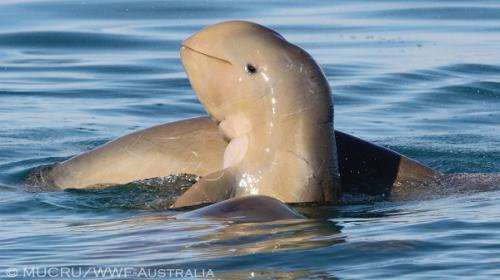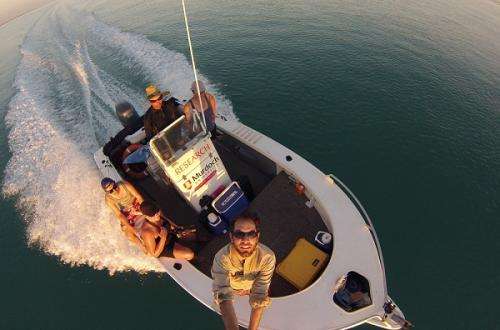Roebuck Bay, a special place for snubfin dolphins

One of the great scientific surprises in recent times is how an inshore dolphin with a melon shaped head and smiley mouth, was discovered as Australia's first endemic species of dolphin as recently as 2005.
Particularly as Roebuck Bay—on the shores of Broome, has the largest known population of snubfin dolphins and pods are often seen in the bay's busy deep water channel and around the creek mouths.
While these peculiar looking cetaceans are incredibly enigmatic and intriguing, for Alex Brown from Murdoch University's Cetacean Research Unit, it was the lack of baseline knowledge that motivated his decision to undertake a PhD on inshore dolphins on the Kimberley coast in 2011.
"My project is addressing the lack of baseline information on inshore dolphins and how they might be influenced by pressure from coastal development across the Kimberley coast. I have been gathering data on their abundance, distribution and genetic connectivity," Alex says.
It is a rare opportunity to be on a boat for the day with Alex and his research assistants—all passionate marine scientists, mad keen on cetaceans. Everyone's buoyed up, having just finished their month long survey of zigzag transects of Roebuck Bay (seven times), equalling what they did last October.
"During the zigzags, photos of individuals are taken using individual marks on their dorsal fins. We then use a mathematical model to estimate how many dolphins are using that area of the bay over the course of the study period.
"After several months of work in Cygnet Bay and Roebuck Bay, we've now photographically identified over 170 different snubfin dolphins from unique marks on their dorsal fins. And our encounters with larger, socialising groups have resulted in some spectacular images of these intriguing animals," Alex says.
In a report submitted by Alex to WWF-Australia in February this year, it is documented that Roebuck Bay has the largest known population of Australian snubfin dolphins to date.

A day out on the sea: how do researchers measure dolphin genetics?
The target today is to get more information on the genetics of snubbies and this means spending the day in known spots where they hang out and the use of a specialised dart gun to get small tissue samples from individual dolphins.
There are no disappointments; more than forty snubbies are sighted socialising, feeding, even squirting – a 'water spitting' technique that herds fish – and on this occasion, attracts a tern that hovers in expectation for a feed just above the dolphin's head.
Hovering on the bow too is Alex, who is waiting for verification of individuals from photos taken by his research assistants, who have a high powered telephoto lens set to continuous shooting mode. Within seconds, snubbies are identified that haven't been biopsied and after assessment that sampling is appropriate (behaviour of dolphins and conditions at sea) Alex takes aim, waiting for the animal to emerge sufficiently from the water for the dart to enter just the right place to secure a small amount of skin or blubber.
Alex's eye is sharp and five new dolphins are sampled. These small tissue samples will help to estimate the level of gene flow (mixing) between dolphin populations in Roebuck Bay and Cygnet Bay.
Distinct dolphin populations in Cygnet and Roebuck Bay
With dolphins being excellent swimmers and Roebuck Bay frequented by over 140 snubfin snubbies, a layperson would likely think the two isolated populations are genetically connected. But this doesn't appear to be so.
"Preliminary data from over 50 tissue samples collected by cetacean researchers Dr Deb Thiele, Simon Allen and myself, from snubfin dolphins in Roebuck Bay and crosschecked with samples from Cygnet Bay, indicate there is limited genetic connectivity between the two populations," Alex says.
"This shows a degree of isolation, and suggests that they should be managed as separate populations."
Research shared at Science on the Broome Coast series
As would be expected, Alex has been keen to share his exciting research, providing a fascinating presentation on April 9 at Broome Public Library. The presentation, which included photos and footage of dolphins, was part of the Science on the Broome Coast series being run by the Roebuck Bay Working Group and sponsored by Inspiring Australia.
An important outcome of Alex Brown's research is the knowledge that Roebuck Bay's snubbies need careful informed management, and runoff and rubbish entering Roebuck Bay needs to be minimised.
Fishers also need to be on the lookout for these dolphins, especially around Roebuck Bay's creek mouths, shallow muddy waters and mangroves. Moreover, in the deep water channel where boats may travel faster, it's a matter of slowing right down if a snubbie is sighted close by, at least until well past.
And if you have a smartphone or android, why not download a free app that will allow you to take a photo of WA's dolphins in coastal waters and upload it to the Coastal Walkabout website, where it can contribute to better scientific understanding.
Provided by Science Network WA





















